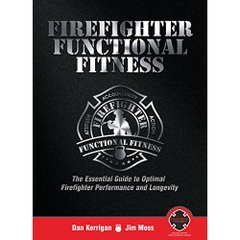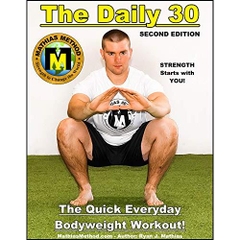-
-
-
Tổng tiền thanh toán:
-
-
Thông tin
-
Tìm sách theo yêu cầu
Over one million readers have turned to Strength Training Anatomy for strength training’s most effective exercises. Now put those exercises to work for you with The Strength Training Anatomy Workout.
The Strength Training Anatomy Workout is your guide to creating the body and the results you want. Strengthen arms and legs; increase muscle mass; sculpt chest, back, and core; firm glutes; increase hip flexibility . . . it’s all here, and all in the stunning detail that only Frédéric Delavier can provide!
Over 150 full-color illustrations allow you to get inside more than 200 exercises and 50 workouts to see how muscles interact with surrounding joints and skeletal structures. You’ll also discover how variations, progressions, and sequencing can affect muscle recruitment, the underlying structures, and ultimately the results.
Product Details
Paperback: 256 pages
- Publisher: Human Kinetics; 1 edition (March 16, 2011)
- Language: English
- ISBN-10: 1450400957
- ISBN-13: 978-1450400954
- Product Dimensions: 10 x 7.7 x 0.7 inches
- Shipping Weight: 2.2 pounds (View shipping rates and policies)
- Average Customer Review: 4.4 out of 5 stars See all reviews (50 customer reviews)
- Amazon Best Sellers Rank: #22,527 in Books (See Top 100 in Books)
- #36 in Books > Health, Fitness & Dieting > Exercise & Fitness > Weight Training
- #69 in Books > Sports & Outdoors > Coaching > Training & Conditioning
Editorial Reviews
About the Author
Frédéric Delavier is a gifted artist with an exceptional knowledge of human anatomy. He studied morphology and anatomy for five years at the prestigious École des Beaux-Arts in Paris and studied dissection for three years at the Paris Faculté de Médecine.
The former editor in chief of the French magazine PowerMag, Delavier is currently a journalist for the French magazine Le Monde du Muscle and a contributor to several other muscle publications, including Men's Health Germany. He is the author of the best-selling Strength Training Anatomy and Women’s Strength Training Anatomy.
Delavier won the French powerlifting title in 1988 and makes annual presentations on the sport applications of biomechanics at conferences in Switzerland. His teaching efforts have earned him the Grand Prix de Techniques et de Pédagogie Sportive. Delavier lives in Paris, France.
Michael Gundill, MBA, has written 13 books on strength training, sport nutrition, and health. His books have been translated into multiple languages, and he has written over 500 articles for bodybuilding and fitness magazines around the world, including Iron Man and Dirty Dieting. In 1998 he won the Article of the Year award at the Fourth Academy of Bodybuilding Fitness & Sports Awards in California.
Gundill started weightlifting in 1983 in order to improve his rowing performances. Most of his training years were spent completing specific lifting programs in his home. As he gained muscle and refined his program, he began to learn more about physiology, anatomy, and biomechanics and started studying those subjects in medical journals. Since 1995 he has been writing about his discoveries in various bodybuilding and fitness magazines all over the world.
Most Helpful Customer Reviews
66 of 67 people found the following review helpfulBy Susanna Hutcheson TOP 500 REVIEWER on March 25, 2011
Format: Paperback
5 Comments Was this review helpful to you? YesNoAll too often we do our workouts without a thought to the muscles we're working. That's a major mistake. I like to plan each workout around the muscles I want to work. I want to know how much weight I need to devote to each muscle group and why. That's where this book comes in.
For example, last night I planned today's workout using this book. I wanted to work the compound muscle groups of the upper body and also hit the triceps and biceps. So I looked in the book.
First, let's take a look at the contents and how the book is laid out.
Part I: Develop Your Bodybuilding Program
Equipment
Diversify Resistance for Maximum Effectiveness
How a Muscle Gains Strength
Mechanisms of Muscle Enlargement
How Muscles Increase Their Endurance
Contraindications to Bodybuilding
Clearly Define Your Objectives
Quantify Your Objectives
20 Steps to Developing Your Program
Rates of Progress
Role of Diet
Warm-Up Techniques
Cool-Down (Return to Calm)
Keep a Workout Notebook
Analyze Your Workouts
Using Video
Techniques for Increasing Intensity
Inroad Theory
Theory of Absolute Strength
Train to Muscle Failure?
Beyond Failure
Cheat Repetitions
Forced Repetitions
Tapering
Rest Break
Negatives
Stop-and-Go
Burn....
Continuous Tension
Unilateral Training
Supersets
Circuits
How Should You Breathe While Exercising?
Part II: Exercises
Strengthen Your Arms
Bigger Shoulders
Sculpt Your Chest
Strengthen Your Neck
Sculpt Your Back
Strengthen Your Thighs
Strengthen Your Legs
Firm Up Your Glutes
Flexibility in the Rotator Muscles of the Hip
Sculpt Your Core
Exercises for the Diaphragm and Respiratory Muscles
Part III: Programming
1. Men's Strength
2. Women's Strength
3. Sport-Specific Training
Now, I have to tell you, that's a lot to get into a 256 page book.
Let's say you want to work out your legs. You turn to the section with the blue edges. These are the workout pages and they're divided into sections for each part of the body.
You'll see the anatomy of the entire body and the parts that each exercise works. You simply plan your workout based on that information.
But, there's more.
You get helpful hints. For example, "When the lumbar muscles get tired, it becomes more and more difficult to maintain the slight natural arch of the back. The spine will start to curve. In this case, reduce the range of motion so that you can always keep your back straight and maintain muscular tension in the hamstrings."
You'll also notice there are advantages and disadvantages to each exercise. Moreover, you're given the option to use free weights, bodyweight or strength bands. Notice I didn't say anything about gym equipment?
That's because the author has rightly made it known that you can get a great workout right at home. No gym required.
"Gyms emphasize the fun aspects of exercising and do not focus on effectiveness," the author Frederic Delavier explains. "This is why gyms often choose equipment that looks nice over equipment that works well."
Delavier believes you should use a combination of bodyweight, strength bands and free weights. While I don't agree with everything he says, I understand his reasoning.
I love the way the book tells the reader how to work out, how to breath while exercising and all the really important fundamentals of working out.
Few people, including most experts, agree on working out to failure. The author gives us reasons why it's good and why it's not. More importantly, he tells us when it will help and when it could hurt.
He says that in terms of inroading (tiring the muscle), stopping before failure causes a weak inroad. Pushing to failure causes a noticeable inroad and going beyond failure causes a serious inroad.
He also discusses cheat reps --- "When you reach failure, this does not mean the muscle has no strength left. It just does not have enough to lift the weight you are using anymore."
This is an excellent workout book. Delavier always delivers and he has outdone himself with this book. While it's directed at athletes, the book is really for anyone who works out and wants to do it right and to understand what effect each exercise has on the muscles.
And, as in my case, it's a great tool in planning your workouts.
Highly recommended.
-- Susanna K. Hutcheson
For example, last night I planned today's workout using this book. I wanted to work the compound muscle groups of the upper body and also hit the triceps and biceps. So I looked in the book.
First, let's take a look at the contents and how the book is laid out.
Part I: Develop Your Bodybuilding Program
Equipment
Diversify Resistance for Maximum Effectiveness
How a Muscle Gains Strength
Mechanisms of Muscle Enlargement
How Muscles Increase Their Endurance
Contraindications to Bodybuilding
Clearly Define Your Objectives
Quantify Your Objectives
20 Steps to Developing Your Program
Rates of Progress
Role of Diet
Warm-Up Techniques
Cool-Down (Return to Calm)
Keep a Workout Notebook
Analyze Your Workouts
Using Video
Techniques for Increasing Intensity
Inroad Theory
Theory of Absolute Strength
Train to Muscle Failure?
Beyond Failure
Cheat Repetitions
Forced Repetitions
Tapering
Rest Break
Negatives
Stop-and-Go
Burn....
Continuous Tension
Unilateral Training
Supersets
Circuits
How Should You Breathe While Exercising?
Part II: Exercises
Strengthen Your Arms
Bigger Shoulders
Sculpt Your Chest
Strengthen Your Neck
Sculpt Your Back
Strengthen Your Thighs
Strengthen Your Legs
Firm Up Your Glutes
Flexibility in the Rotator Muscles of the Hip
Sculpt Your Core
Exercises for the Diaphragm and Respiratory Muscles
Part III: Programming
1. Men's Strength
2. Women's Strength
3. Sport-Specific Training
Now, I have to tell you, that's a lot to get into a 256 page book.
Let's say you want to work out your legs. You turn to the section with the blue edges. These are the workout pages and they're divided into sections for each part of the body.
You'll see the anatomy of the entire body and the parts that each exercise works. You simply plan your workout based on that information.
But, there's more.
You get helpful hints. For example, "When the lumbar muscles get tired, it becomes more and more difficult to maintain the slight natural arch of the back. The spine will start to curve. In this case, reduce the range of motion so that you can always keep your back straight and maintain muscular tension in the hamstrings."
You'll also notice there are advantages and disadvantages to each exercise. Moreover, you're given the option to use free weights, bodyweight or strength bands. Notice I didn't say anything about gym equipment?
That's because the author has rightly made it known that you can get a great workout right at home. No gym required.
"Gyms emphasize the fun aspects of exercising and do not focus on effectiveness," the author Frederic Delavier explains. "This is why gyms often choose equipment that looks nice over equipment that works well."
Delavier believes you should use a combination of bodyweight, strength bands and free weights. While I don't agree with everything he says, I understand his reasoning.
I love the way the book tells the reader how to work out, how to breath while exercising and all the really important fundamentals of working out.
Few people, including most experts, agree on working out to failure. The author gives us reasons why it's good and why it's not. More importantly, he tells us when it will help and when it could hurt.
He says that in terms of inroading (tiring the muscle), stopping before failure causes a weak inroad. Pushing to failure causes a noticeable inroad and going beyond failure causes a serious inroad.
He also discusses cheat reps --- "When you reach failure, this does not mean the muscle has no strength left. It just does not have enough to lift the weight you are using anymore."
This is an excellent workout book. Delavier always delivers and he has outdone himself with this book. While it's directed at athletes, the book is really for anyone who works out and wants to do it right and to understand what effect each exercise has on the muscles.
And, as in my case, it's a great tool in planning your workouts.
Highly recommended.
-- Susanna K. Hutcheson
Format: Paperback
Comment Was this review helpful to you? YesNoThis is a very valuable resource for any bodybuilder or fitness minded individual. One of the authors Frederic Delavier is best known for his excellent illustrations in "Strength Training Anatomy" which depicted every muscle used during exercise. "The Strength Training Anatomy Workout" is a high quality addition to that first book. It shows the reader how to put the strength training principles into practice. What I really like about the workout edition is that the authors kept it pretty simple. You don't need tons of equipment to get in shape or perform the exercises described in this book. In fact, the authors even recommend you do these exercises at home. You don't even need a gym unless that's where you prefer to workout. I love how detailed every exercise is explained and the step by step full color pictures. I also really appreciated the included complete workout routines that are tailored to different fitness levels. Overall, it is a very informative book that I can highly recommend. Even if you think you know it all about bodybuilding this book is still a good refresher on proper technique which is key to success in weightlifting.
14 of 16 people found the following review helpfulBy Sundownr on April 18, 2011
Format: Paperback
I found this book to be very informative in ways I had not expected. I was searching for a program of strength building to add to my current cardio and weight-loss plan. "Strength Training Anatomy" gives simplistic steps to creating a strength and muscle-toning (sculpting) program to fit each individual's lifestyle, ability, and time allotment. I did not expect the vast amount of exercise detail, practical advice, and the impressively detailed artwork that displayed the muscle sets to be worked for each. This is the book I have been waiting for and truly needed!!
- Link: http://www.amazon.com/Strength-Training-Anatomy-Frederic-Delavier/dp/1450400957
XEM CHI TIẾT TẠI AMAZON.COM
- Thông tin chi tiết
- Mục lục
- Đánh giá & bình luận của người mua
- Những cuốn sách cùng chủ đề hoặc có liên quan
Tại web chỉ có một phần nhỏ các đầu sách đang có nên nếu cần tìm sách gì các bạn có thể liên hệ trực tiếp với Thư viện qua Mail, Zalo, Fanpage nhé
Đăng ký nhận tin qua email
Hãy đăng ký ngay hôm nay để nhận được những tin tức cập nhật mới nhất về sản phẩm và các chương trình giảm giá, khuyến mại của chúng tôi.












